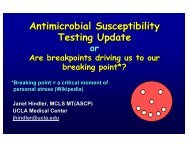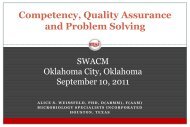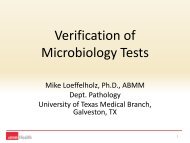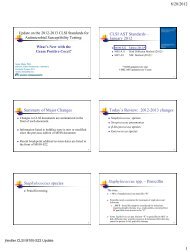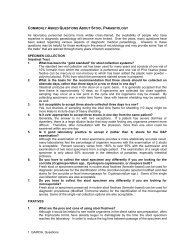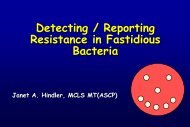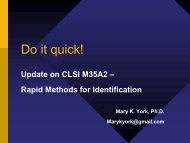Susceptibility Testing of Neisseria and Haemophilus ... - SWACM
Susceptibility Testing of Neisseria and Haemophilus ... - SWACM
Susceptibility Testing of Neisseria and Haemophilus ... - SWACM
Create successful ePaper yourself
Turn your PDF publications into a flip-book with our unique Google optimized e-Paper software.
<strong>Susceptibility</strong> <strong>Testing</strong> <strong>of</strong> <strong>Neisseria</strong><br />
<strong>and</strong> <strong>Haemophilus</strong> influenzae <strong>and</strong><br />
parainfluenzae
Types <strong>of</strong> Infection<br />
<strong>Haemophilus</strong> influenzae<br />
• Invasive<br />
– Meningitis, epiglottitis <strong>and</strong> bacteremia (subacute<br />
endocarditis)<br />
• Typically caused by type B (HIB)<br />
• Otitis media, acute conjunctivitis, acute sinusitis,<br />
bronchitis <strong>and</strong> pneumonia.<br />
<strong>Haemophilus</strong> parainfluenzae<br />
• Otitis media, acute conjunctivitis, acute sinusitis,<br />
bronchitis <strong>and</strong> pneumonia<br />
• Rare cause <strong>of</strong> subacute endocarditis<br />
Non-typeable H. influenzae <strong>and</strong> parainfluenzae together colonize<br />
the pharynges <strong>and</strong> nasopharynges <strong>of</strong> >90% <strong>of</strong> healthy individuals.
<strong>Haemophilus</strong> influenzae<br />
“Amox-clav, azithromycin, clarithromycin, cefaclor, loracabef,<br />
cefdinir, cefixime, cefpodoxime, cefuroxime axetil <strong>and</strong><br />
telithromycin are oral agents that may be used as empiric<br />
therapy for respiratory tract infections due to<br />
<strong>Haemophilus</strong> spp. The results <strong>of</strong> susceptibility tests with<br />
these antimicrobial agents are <strong>of</strong>ten not useful for<br />
management <strong>of</strong> individual patients. However,<br />
susceptibility testing <strong>of</strong> <strong>Haemophilus</strong> spp. with these<br />
compounds may be appropriate for surveillance or<br />
epidemiologic studies.”<br />
CLSI M100-S21 Table 2E
<strong>Haemophilus</strong> influenzae:<br />
Treatment recommendations<br />
Infection Primary Alternative Prevalence <strong>of</strong><br />
Resistance<br />
Meningitis <strong>and</strong><br />
invasive infection<br />
Non-life<br />
threatening<br />
infections<br />
Prophylaxis<br />
Ceftriaxone <strong>and</strong><br />
Cefotaxime<br />
Trim-sulfa, amox/clav,<br />
amp/sulbactam, oral<br />
2 nd or 3 rd generation<br />
cephalosporin<br />
Rifampin<br />
Azithromycin,<br />
clarithromycin,<br />
fluoroquinolone,<br />
amp or penicillin<br />
0% 1<br />
Variable<br />
(next slide)<br />
1. Karlowsky et al. IJAA. 2002
H. Influenzae Resistance<br />
Antibiotic<br />
% Resistance<br />
Ampicillin ~33%<br />
Amox/Clav ~0%<br />
Azithromycin 0%<br />
Trim-Sulfa ~20%<br />
Lev<strong>of</strong>loxacin 0%<br />
Karlowsky et al. AAC. 2003
<strong>Haemophilus</strong> influenzae<br />
• Beta-lactamse testing<br />
(7) The result <strong>of</strong> ampicillin susceptibility tests should<br />
be used to predict the activity <strong>of</strong> amoxicillin. The<br />
majority <strong>of</strong> isolates or H. Influenzae that are<br />
resistant to ampicillin <strong>and</strong> amoxicillin produce a<br />
TEM-type beta-lactamase. In most cases, a direct<br />
beta-lactamase test can provide a rapid means <strong>of</strong><br />
detecting resistance to ampicillin <strong>and</strong> amoxicillin.<br />
Beta-lactamase negative ampicillin resistant strains (BLNAR) <strong>of</strong> H.<br />
influenzae exist <strong>and</strong> should be considered resistant to amox/clav,<br />
amp/sulbactam, cefaclor, cefetamet, cefonicid, cefprozil, cefuroxime,<br />
loracarbef <strong>and</strong> pip/tazo despite apparent in vitro susceptibility <strong>of</strong> some<br />
BLNAR strains to these agents.<br />
CLSI M100-S21 Table 2E
<strong>Haemophilus</strong> influenzae in the<br />
United States 2001-2002<br />
Phenotype<br />
Beta-lactamase negative ampicillin<br />
susceptible (BLNAS)<br />
Beta-lactamase positive ampicillin<br />
resistant(BLPAR)<br />
Beta-lactamase negative ampicillin<br />
resistant(BLNAR)<br />
Prevalence (n=1,434)<br />
1019 (71.1%)<br />
406 (28.3%)<br />
9 (0.6%)<br />
This is the population that is missed by beta-lactamase testing.<br />
Karlowsky et al. 2001. JCM
<strong>Haemophilus</strong> influenzae:<br />
Strategy<br />
• Use Beta-lactamase test clinically significant<br />
isolates.<br />
– If positive report as resistant to amoxicillin <strong>and</strong><br />
ampicillin<br />
• Additional susceptibility testing…<br />
– Consult with MD<br />
– Send to reference lab<br />
– Perform using <strong>Haemophilus</strong> test medium
<strong>Haemophilus</strong> influenzae Test Method<br />
Inoculation:<br />
Direct colony suspension<br />
0.5 McFarl<strong>and</strong><br />
Medium:<br />
DD – <strong>Haemophilus</strong> test medium(HTM)<br />
Broth – HTM broth<br />
Incubation: 35 +/- 2°C<br />
DD – 5% CO 2 16-18 hrs<br />
Broth – Ambient air; 20-24 hrs
<strong>Neisseria</strong> gonorrhoeae - Epidemiology<br />
…but as long as people are still having<br />
promiscuous sex with many anonymous<br />
partners without protection while at the same<br />
time experimenting with mind-exp<strong>and</strong>ing<br />
drugs in a consequence-free environment, I'll<br />
be sound as a pound!<br />
CDC implementation <strong>of</strong> GC control program in the mid<br />
70’s.<br />
- Decreased incidence <strong>of</strong> GC in the US by<br />
74%<br />
- However, 5.5% increase from 2005-2006
Current <strong>Neisseria</strong> gonorrhoeae<br />
Treatment recommendations<br />
Infection Primary Alternative<br />
Urethritis, cervicitis <strong>and</strong><br />
proctitis<br />
Conjunctivitis<br />
Disseminated gonococcal<br />
infection (DGI)<br />
Pharyngitis<br />
Ceftriaxone or cefixime<br />
PLUS doxycycline or<br />
azithromycin<br />
Ceftriaxone IM<br />
IM or IV Ceftriaxone<br />
Ceftriaxone IM PLUS<br />
doxycycline or azithromycin<br />
IV Cefotaxime or IV<br />
ceftizoxime<br />
As <strong>of</strong> 2007, fluoroquinolones no longer recommended due to widespread<br />
emergence <strong>of</strong> resistance.<br />
MMWR 2010 – Dec 17, 2010 – STD Treatment Guidelines
4% 0.9%<br />
0%<br />
0%<br />
Drug<br />
Susceptible<br />
(MIC (µg/mL))<br />
Susceptible<br />
(Disk (mm))<br />
Cefotaxime = 31<br />
Ceftriaxone = 35<br />
Cefixime = 29<br />
Azithromycin Eucast
http://www.cdc.gov/std/gisp2009/okc-2009.pdf<br />
<strong>Neisseria</strong> gonorrhoeae: Regional Resistance<br />
Oklahoma City, OK<br />
Azithromycin<br />
Ceftriaxone<br />
“Breakpoint”<br />
Breakpoint<br />
Cipr<strong>of</strong>loxacin<br />
Cefixime<br />
Breakpoint
<strong>Neisseria</strong> gonorrhoeae: Regional Treatment<br />
Oklahoma City, OK<br />
Breakpoint<br />
http://www.cdc.gov/std/gisp2009/okc-2009.pdf
<strong>Neisseria</strong> gonorrhoeae: <strong>SWACM</strong> Region<br />
Different in Dallas…<br />
Same treatment pattern in MO <strong>and</strong> LA but with AZT<br />
susceptibility patterns resembling that <strong>of</strong> OKC<br />
http://www.cdc.gov/std/gisp2009/default.htm
<strong>Neisseria</strong> gonorrhoeae:<br />
<strong>Susceptibility</strong> testing<br />
• Isolation <strong>of</strong> organism rare in era <strong>of</strong> NAAT<br />
• Not performed by most laboratories<br />
– Requires specialized media which includes GC agar<br />
base <strong>and</strong> growth supplement.<br />
• Generally performed by state <strong>and</strong> public<br />
health laboratories for epidemiological<br />
purposes.<br />
• Not usually performed by reference labs.<br />
– Not Mayo, Focus or ARUP
Current <strong>Neisseria</strong> meningitidis:<br />
Treatment recommendations<br />
Indication Primary Alternative<br />
Central nervous system Ceftriaxone Chloramphenicol,<br />
Meropenem or<br />
Moxifloxacin<br />
Prophylaxis<br />
Cipro, Ceftriaxone or<br />
Rifampin<br />
Edopthalmitis Ceftriaxone or cefotaxime<br />
Bacteremia Ceftriaxone Lev<strong>of</strong>loxacin or<br />
Moxifloxacin<br />
Sanford Guide - 2009
Important points for testing <strong>of</strong><br />
fastidious GNRs<br />
• N. meningitidis testing should be performed in<br />
a biological safety cabinet (BSC).<br />
– Laboratory acquired disease is associated with a<br />
case fatality rate <strong>of</strong> 50%.<br />
• Substantially higher than that <strong>of</strong> the general population<br />
(12-15%)<br />
• Even if you’ve been vaccinated…<br />
– Vaccine not 100% effective<br />
– Does not protect against serogroup B which<br />
caused 50% <strong>of</strong> lab acquired disease in 2000.<br />
http://www.cdc.gov/biosafety/publications/bmbl5/BMBL.pdf
<strong>Neisseria</strong> meningitidis:<br />
MIC <strong>and</strong> Disk diffusion methods<br />
CLSI – M100-S21
<strong>Neisseria</strong> meningitidis:<br />
Therapeutic Agents<br />
*Penicillin<br />
*Ampicillin<br />
Cefotaxime<br />
Ceftriaxone<br />
Meropenem<br />
Chloramphenicol<br />
All drugs listed are in Test/Report Group C<br />
“Supplemental, Report Selectively”..implies routine<br />
testing not necessary<br />
*No disk diffusion breakpoints; must do MIC test
<strong>Neisseria</strong> meningitidis: Agents for Prophylaxis<br />
Azithromycin<br />
Cipr<strong>of</strong>loxacin<br />
Minocycline<br />
Nalidixic acid<br />
(for surveillance only; may<br />
detect diminished<br />
fluoroquinolone susceptibility)<br />
Rifampin<br />
Trimethoprim-sulfamethoxazole<br />
(predicts susceptibility to<br />
sulfonamides also)<br />
• (9) May be appropriate<br />
only for prophylaxis <strong>of</strong><br />
meningococcal case<br />
contacts. These<br />
interpretive criteria do<br />
not apply to therapy <strong>of</strong><br />
patients with invasive<br />
meningococcal disease.<br />
All drugs listed are in Test/Report Group C “Supplemental, Report<br />
Selectively”..implies routine testing not necessary<br />
CLSI – M100-S21
<strong>Neisseria</strong> meningitidis:<br />
Resistance Issues<br />
• Rare ß-lactamase producing isolates<br />
– 6 to date; most recent 1996 (Spain)<br />
– None isolated <strong>of</strong> 442 collected from ABCs network<br />
• Between 1917 <strong>and</strong> 2004<br />
• Penicillin “I” or “R” isolates<br />
– Mechanism – altered PBP<br />
– MICs to extended-spectrum cephalosporins remain low<br />
• Resistance to prophylactic agents:<br />
– Sulfonamides - (common)<br />
– Cipr<strong>of</strong>loxacin - (rare)<br />
– Rifampin – (uncommon)<br />
Jorgensen et al. 2005. JCM



